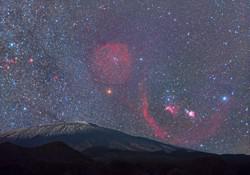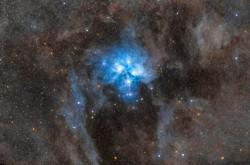Glossary term: Interstellar Medium
Description: The interstellar medium (ISM) is a term to describe all of the gas and dust that lies between star systems in a galaxy. Our Solar System lies in the disk of the Milky Way where most of the ISM is atomic hydrogen mixed with atomic helium and dust.
The ISM has a very low density compared to planetary atmospheres, with a typical density less than one particle per cubic centimeter, roughly 50 billion, billion times less dense than the Earth's atmosphere. This density varies greatly, along with the temperature, across the Galaxy with the ISM split into several different components.
The largest components by volume in the galactic disk are the warm atomic gas and warm ionized gas, both with temperatures around 8000 kelvins (K) and densities around half an atom or ion per cubic centimeter. A smaller volume is in the form of colder, denser atomic gas with a temperature around 40 K. A still smaller volume of the ISM is in the form of denser (up to a million molecules per cubic centimeter), colder (<20 K) clouds of molecular hydrogen. Some of these molecular clouds will collapse under their own gravity, leading to the formation of new stars. Molecular clouds in the Milky Way are mostly found in its spiral arms. The gas surrounding the Milky Way's disk is very hot (millions of kelvins) and very low density.
Stars put gas and dust back into the ISM through stellar winds and supernovae. The gas and dust returned to the ISM have a higher fraction of heavy elements (metals), thus enriching the galaxy over time. The gas and dust in the interstellar medium is the main cause of interstellar extinction.
Related Terms:
- Dust
- Extinction
- Galactic Disk
- Gas
- Milky Way
- Planetary Nebula
- Solar System
- Solar Wind
- Spiral Galaxy
- Star Formation
- Supernova
- Interstellar Extinction
See this term in other languages
Term and definition status: This term and its definition have been approved by a research astronomer and a teacher
The OAE Multilingual Glossary is a project of the IAU Office of Astronomy for Education (OAE) in collaboration with the IAU Office of Astronomy Outreach (OAO). The terms and definitions were chosen, written and reviewed by a collective effort from the OAE, the OAE Centers and Nodes, the OAE National Astronomy Education Coordinators (NAECs) and other volunteers. You can find a full list of credits here. All glossary terms and their definitions are released under a Creative Commons CC BY-4.0 license and should be credited to "IAU OAE".
If you notice a factual error in this glossary definition then please get in touch.
Related Media
Orion Rises Over Mount Etna
Credit: Dario Giannobile/IAU OAE
License: CC-BY-4.0 Creative Commons Attribution 4.0 International (CC BY 4.0) icons
The Pleiades M45 with Majestic Dust
Credit: Mohamed Usama/IAU OAE
License: CC-BY-4.0 Creative Commons Attribution 4.0 International (CC BY 4.0) icons










